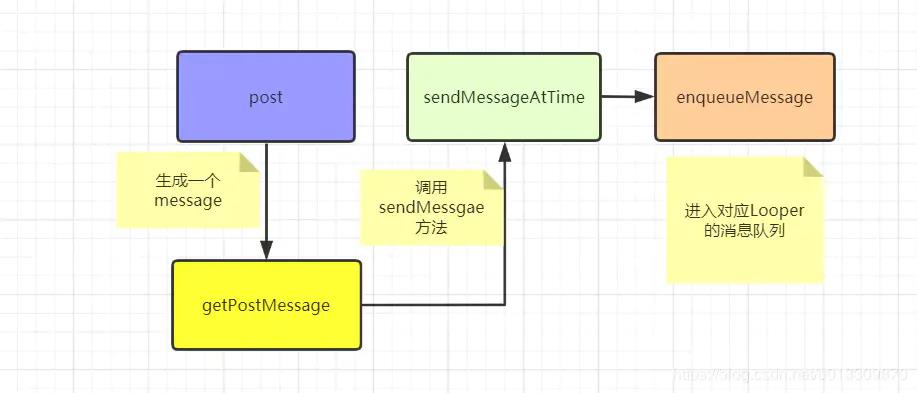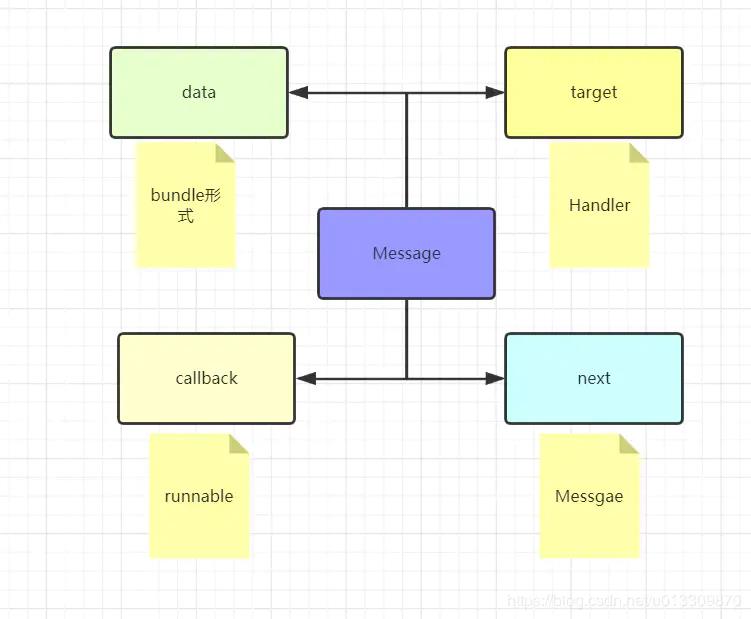Android面试:Handler八大问题汇总
Posted 冬天的毛毛雨
tags:
篇首语:本文由小常识网(cha138.com)小编为大家整理,主要介绍了Android面试:Handler八大问题汇总相关的知识,希望对你有一定的参考价值。
前言
Handler机制几乎是android面试时必问的问题,虽然看过很多次handler源码,但是有些面试官问的问题却不一定能够回答出来,趁着机会总结一下面试中所覆盖的handler知识点。
1、讲讲 Handler 的底层实现原理?
下面的这幅图很完整的表现了整个handler机制。

要理解handler的实现原理,其实最重要的是理解Looper的实现原理,Looper才是实现handler机制的核心。任何一个handler在使用sendMessage或者post时候,都是先构造一个Message,并把自己放到message中,然后把Message放到对应的Looper的MessageQueue,Looper通过控制MessageQueue来获取message执行其中的handler或者runnable。 要在当前线程中执行handler指定操作,必须要先看当前线程中有没有looper,如果有looper,handler就会通过sendMessage,或者post先构造一个message,然后把message放到当前线程的looper中,looper会在当前线程中循环取出message执行,如果没有looper,就要通过looper.prepare()方法在当前线程中构建一个looper,然后主动执行looper.loop()来实现循环。
梳理一下其实最简单的就下面四条:
1、每一个线程中最多只有一个Looper,通过ThreadLocal来保存,Looper中有Message队列,保存handler并且执行handler发送的message。
2、在线程中通过Looper.prepare()来创建Looper,并且通过ThreadLocal来保存Looper,每一个线程中只能调用一次Looper.prepare(),也就是说一个线程中最多只有一个Looper,这样可以保证线程中Looper的唯一性。
3、handler中执行sendMessage或者post操作,这些操作执行的线程是handler中Looper所在的线程,和handler在哪里创建没关系,和Handler中的Looper在那创建有关系。
4、一个线程中只能有一个Looper,但是一个Looper可以对应多个handler,在同一个Looper中的消息都在同一条线程中执行。
2、Handler机制,sendMessage和post(Runnable)的区别?
要看sendMessage和post区别,需要从源码来看,下面是几种使用handler的方式,先看下这些方式,然后再从源码分析有什么区别。 例1、 主线程中使用handler
//主线程
Handler mHandler = new Handler(new Handler.Callback() {
@Override
public boolean handleMessage(@NonNull Message msg) {
if (msg.what == 1) {
//doing something
}
return false;
}
});
Message msg = Message.obtain();
msg.what = 1;
mHandler.sendMessage(msg);
上面是在主线程中使用handler,因为在Android中系统已经在主线程中生成了Looper,所以不需要自己来进行looper的生成。如果上面的代码在子线程中执行,就会报
Can't create handler inside thread " + Thread.currentThread()
+ " that has not called Looper.prepare()
如果想着子线程中处理handler的操作,就要必须要自己生成Looper了。
例2 、子线程中使用handler
Thread thread=new Thread(new Runnable() {
@Override
public void run() {
Looper.prepare();
Handler handler=new Handler();
handler.post(new Runnable() {
@Override
public void run() {
}
});
Looper.loop();
}
});
上面在Thread中使用handler,先执行Looper.prepare方法,来在当前线程中生成一个Looper对象并保存在当前线程的ThreadLocal中。 看下Looper.prepare()中的源码:
//prepare
private static void prepare(boolean quitAllowed) {
if (sThreadLocal.get() != null) {
throw new RuntimeException("Only one Looper may be created per thread");
}
sThreadLocal.set(new Looper(quitAllowed));
}
//Looper
private Looper(boolean quitAllowed) {
mQueue = new MessageQueue(quitAllowed);
mThread = Thread.currentThread();
}
可以看到prepare方法中会先从sThreadLocal中取如果之前已经生成过Looper就会报错,否则就会生成一个新的Looper并且保存在线程的ThreadLocal中,这样可以确保每一个线程中只能有一个唯一的Looper。
另外:由于Looper中拥有当前线程的引用,所以有时候可以用Looper的这种特点来判断当前线程是不是主线程。
@RequiresApi(api = Build.VERSION_CODES.KITKAT)
boolean isMainThread() {
return Objects.requireNonNull(Looper.myLooper()).getThread() ==
Looper.getMainLooper().getThread();
}
sendMessage vs post
先来看看sendMessage的代码调用链:

enqueueMessage源码如下:
private boolean enqueueMessage(@NonNull MessageQueue queue, @NonNull Message msg,
long uptimeMillis) {
msg.target = this;
msg.workSourceUid = ThreadLocalWorkSource.getUid();
return queue.enqueueMessage(msg, uptimeMillis);
}
enqueueMessage的代码处理很简单,msg.target = this;就是把当前的handler对象给message.target。然后再讲message进入到队列中。
post代码调用链:

调用post时候会先调用getPostMessage生成一个Message,后面和sendMessage的流程一样。下面看下getPostMessage方法的源码:
private static Message getPostMessage(Runnable r) {
Message m = Message.obtain();
m.callback = r;
return m;
}
可以看到getPostMessage中会先生成一个Messgae,并且把runnable赋值给message的callback.消息都放到MessageQueue中后,看下Looper是如何处理的。
for (;;) {
Message msg = queue.next(); // might block
if (msg == null) {
return;
}
msg.target.dispatchMessage(msg);
}
Looper中会遍历message列表,当message不为null时调用msg.target.dispatchMessage(msg)方法。看下message结构:

也就是说msg.target.dispatchMessage方法其实就是调用的Handler中的dispatchMessage方法,下面看下dispatchMessage方法的源码:
public void dispatchMessage(@NonNull Message msg) {
if (msg.callback != null) {
handleCallback(msg);
} else {
if (mCallback != null) {
if (mCallback.handleMessage(msg)) {
return;
}
}
handleMessage(msg);
}
}
//
private static void handleCallback(Message message) {
message.callback.run();
}
因为调用post方法时生成的message.callback=runnable,所以dispatchMessage方法中会直接调用 message.callback.run();也就是说直接执行post中的runnable方法。 而sendMessage中如果mCallback不为null就会调用mCallback.handleMessage(msg)方法,否则会直接调用handleMessage方法。
总结 post方法和handleMessage方法的不同在于,post的runnable会直接在callback中调用run方法执行,而sendMessage方法要用户主动重写mCallback或者handleMessage方法来处理。
3、Looper会一直消耗系统资源吗?
首先给出结论,Looper不会一直消耗系统资源,当Looper的MessageQueue中没有消息时,或者定时消息没到执行时间时,当前持有Looper的线程就会进入阻塞状态。

下面看下looper所在的线程是如何进入阻塞状态的。looper阻塞肯定跟消息出队有关,因此看下消息出队的代码。
消息出队
Message next() {
// Return here if the message loop has already quit and been disposed.
// This can happen if the application tries to restart a looper after quit
// which is not supported.
final long ptr = mPtr;
if (ptr == 0) {
return null;
}
int nextPollTimeoutMillis = 0;
for (;;) {
if (nextPollTimeoutMillis != 0) {
Binder.flushPendingCommands();
}
nativePollOnce(ptr, nextPollTimeoutMillis);
// While calling an idle handler, a new message could have been delivered
// so go back and look again for a pending message without waiting.
if(hasNoMessage)
{
nextPollTimeoutMillis =-1;
}
}
}
上面的消息出队方法被简写了,主要看下面这段,没有消息的时候nextPollTimeoutMillis=-1;
if(hasNoMessage)
{
nextPollTimeoutMillis =-1;
}
看for循环里面这个字段所其的作用:
if (nextPollTimeoutMillis != 0) {
Binder.flushPendingCommands();
}
nativePollOnce(ptr, nextPollTimeoutMillis);
Binder.flushPendingCommands();这个方法的作用可以看源码里面给出的解释:
/**
* Flush any Binder commands pending in the current thread to the kernel
* driver. This can be
* useful to call before performing an operation that may block for a long
* time, to ensure that any pending object references have been released
* in order to prevent the process from holding on to objects longer than
* it needs to.
*/
也就是说在用户线程要进入阻塞之前跟内核线程发送消息,防止用户线程长时间的持有某个对象。再看看下面这个方法:nativePollOnce(ptr, nextPollTimeoutMillis);当nextPollingTimeOutMillis=-1时,这个native方法会阻塞当前线程,线程阻塞后,等下次有消息入队才会重新进入可运行状态,所以Looper并不会一直死循环消耗运行内存,对队列中的颜色消息还没到时间时也会阻塞当前线程,但是会有一个阻塞时间也就是nextPollingTimeOutMillis>0的时间。
当消息队列中没有消息的时候looper肯定是被消息入队唤醒的。
消息入队
boolean enqueueMessage(Message msg, long when) {
if (msg.target == null) {
throw new IllegalArgumentException("Message must have a target.");
}
if (msg.isInUse()) {
throw new IllegalStateException(msg + " This message is already in use.");
}
synchronized (this) {
if (mQuitting) {
IllegalStateException e = new IllegalStateException(
msg.target + " sending message to a Handler on a dead thread");
Log.w(TAG, e.getMessage(), e);
msg.recycle();
return false;
}
msg.markInUse();
msg.when = when;
Message p = mMessages;
boolean needWake;
if (p == null || when == 0 || when < p.when) {
// New head, wake up the event queue if blocked.
msg.next = p;
mMessages = msg;
needWake = mBlocked;
} else {
// Inserted within the middle of the queue. Usually we don't have to wake
// up the event queue unless there is a barrier at the head of the queue
// and the message is the earliest asynchronous message in the queue.
needWake = mBlocked && p.target == null && msg.isAsynchronous();
Message prev;
for (;;) {
prev = p;
p = p.next;
if (p == null || when < p.when) {
break;
}
if (needWake && p.isAsynchronous()) {
needWake = false;
}
}
msg.next = p; // invariant: p == prev.next
prev.next = msg;
}
// We can assume mPtr != 0 because mQuitting is false.
if (needWake) {
nativeWake(mPtr);
}
}
return true;
}
上面可以看到消息入队之后会有一个
if (needWake) {
nativeWake(mPtr);
}
方法,调用这个方法就可以唤醒线程了。另外消息入队的时候是根据消息的delay时间来在链表中排序的,delay时间长的排在后面,时间短的排在前面。如果时间相同那么按插入时间先后来排,插入时间早的在前面,插入时间晚的在后面。
4、android的Handle机制,Looper关系,主线程的Handler是怎么判断收到的消息是哪个Handler传来的?
Looper是如何判断Message是从哪个handler传来的呢?其实很简单,在1中分析过,handler在sendMessage的时候会构建一个Message对象,并且把自己放在Message的target里面,这样的话Looper就可以根据Message中的target来判断当前的消息是哪个handler传来的。
5、Handler机制流程、Looper中延迟消息谁来唤醒Looper?
从3中知道在消息出队的for循环队列中会调用到下面的方法。
nativePollOnce(ptr, nextPollTimeoutMillis);
如果是延时消息,会在被阻塞nextPollTimeoutMillis时间后被叫醒,nextPollTimeoutMillis就是消息要执行的时间和当前的时间差。
6、Handler是如何引起内存泄漏的?如何解决?
在子线程中,如果手动为其创建Looper,那么在所有的事情完成以后应该调用quit方法来终止消息循环,否则这个子线程就会一直处于等待的状态,而如果退出Looper以后,这个线程就会立刻终止,因此建议不需要的时候终止Looper。
Looper.myLooper().quit()
那么,如果在Handler的handleMessage方法中(或者是run方法)处理消息,如果这个是一个延时消息,会一直保存在主线程的消息队列里,并且会影响系统对Activity的回收,造成内存泄露。
具体可以参考Handler内存泄漏分析及解决
总结一下,解决Handler内存泄露主要2点
1 、有延时消息,要在Activity销毁的时候移除Messages
2、 匿名内部类导致的泄露改为匿名静态内部类,并且对上下文或者Activity使用弱引用。
7、handler机制中如何确保Looper的唯一性?
Looper是保存在线程的ThreadLocal里面的,使用Handler的时候要调用Looper.prepare()来创建一个Looper并放在当前的线程的ThreadLocal里面。
private static void prepare(boolean quitAllowed) {
if (sThreadLocal.get() != null) {
throw new RuntimeException("Only one Looper may be created per thread");
}
sThreadLocal.set(new Looper(quitAllowed));
}
可以看到,如果多次调用prepare的时候就会报Only one Looper may be created per thread,所以这样就可以保证一个线程中只有唯一的一个Looper。
8、Handler 是如何能够线程切换,发送Message的?
handler的执行跟创建handler的线程无关,跟创建looper的线程相关,加入在子线程中创建一个Handler,但是Handler相关的Looper是主线程的,这样,如果handler执行post一个runnable,或者sendMessage,最终的handle Message都是在主线程中执行的。
Thread thread=new Thread(new Runnable() {
@Override
public void run() {
Looper.prepare();
Handler handler=new Handler(getMainLooper());
handler.post(new Runnable() {
@Override
public void run() {
Toast.makeText(MainActivity.this,"hello,world",Toast.LENGTH_LONG).show();
}
});
Looper.loop();
}
});
thread.start();
最后
小编在网上收集了一些 Android 开发相关的学习文档、面试题、Android 核心笔记等等文档,希望能帮助到大家学习提升,如有需要参考的可以直接去我 CodeChina地址:https://codechina.csdn.net/u012165769/Android-T3 访问查阅。

以上是关于Android面试:Handler八大问题汇总的主要内容,如果未能解决你的问题,请参考以下文章